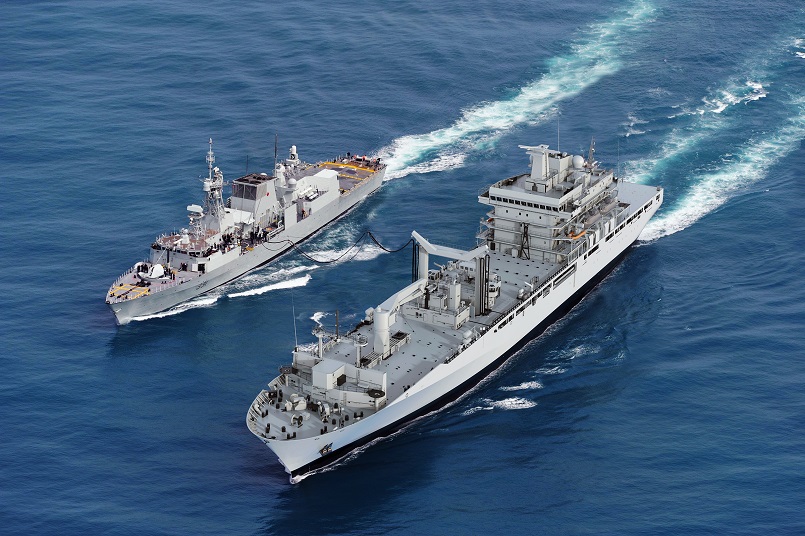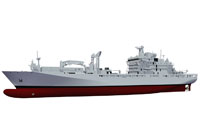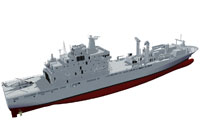Joint support ship (JSS)
Project summary
The Royal Canadian Navy needs support ships. The Joint Support Ship (JSS) project will deliver two new ships, as outlined in Strong, Secured, Engaged, Canada’s defence policy. These Joint Support Ships are being built for the RCN under the National Shipbuilding Strategy and will replace the auxiliary oiler replenishment (AOR) vessels that reached the end of their operational lives.
The future Joint Support Ship will provide:
- Underway Support to Naval Task Groups: Underway support is best described as the re-supply of fuel, food, ammunition, spare parts and other supplies between ships at sea. This includes the operation and maintenance of helicopters, as well as task group medical and dental facilities;
- Limited Sealift: JSS will be capable of transporting and delivering cargo both in support of task group operations and in support to operations ashore; and
- Limited Support to Operations Ashore: To meet a range of possibilities in an uncertain future security environment, the JSS will leverage its onboard facilities to support operations ashore, including anything from combat to humanitarian and disaster relief.
- Self-defence functions and the ability to respond to Chemical, Biological, Radiological and Nuclear (CBRN) threats to allow for operations in high threat environments.
The early construction phase of the future Protecteur-class ships, began in June 2018 at Seaspan’s Vancouver Shipyards Co. Ltd. Delivery of the first vessel, the future HMCS Protecteur, is planned for 2026. Following which, the RCN will conduct a series of trials to ensure the ship meets advanced operational requirements , such as certification for helicopter operations. Construction of the second ship, the future HMCS Preserver, commenced in May 2022 with delivery to the RCN planned for 2027.
Project phases

Currently in Phase 4: Implementation
1. Identification
1. Identification
- Completed through the National Shipbuilding Strategy
2. Options analysis
2. Options analysis
- Completed through the National Shipbuilding Strategy
3. Definition
3. Definition
- Revised project approval 1: June 10, 2010
- Revised project approval 2: April 3, 2014
- Revised project approval 3: December 4, 2014
- Revised project approval 4: June 11, 2015
- Revised project approval 5: August 22, 2016
- Revised project approval 6: April 26, 2018
4. Implementation
4. Implementation
- Project approval for early block construction: April 26, 2018
- Steel cut for first full ship: 2018
- Project approval implementation: February 27, 2020
- Contract award: June 10, 2020
- Steel cut for second ship: 2022
- Launch of the first ship: 2023
- First delivery: 2026
- Initial operational capability: 2026
- Final delivery: 2027
- Full operational capability: 2028
5. Close-out
5. Close-out
- 2029 (under review)
Learn more about the Defence procurement process.
Additional information
Project updates
Project updates
February 15, 2025
Delivery of the first JSS has been delayed by six months from 2025 to 2026. This is primarily due to the first ship requiring more production effort, and more time than originally anticipated. The production of the second ship is not affected, and delivery remains in 2027.
December 22, 2024
The first JSS was successfully launched at Seaspan’s Vancouver Shipyards.
December 13, 2024
The RCN held a formal naming ceremony for the first JSS, which is known as the future HMCS Protecteur.
March 21, 2024
The final of four new sea-to-shore connector systems, which are modular, deployable self-propelled systems for transporting supplies from ship to shore that can be embarked on JSS, was successfully delivered by Navamar of Montreal, Québec. These systems are now stored on both East and West Coasts.
October 2023
The first JSS is 100% consolidated (all major structural steel components in place). 45 of 115 blocks were under construction for the second JSS. 20 blocks were structurally complete.
A ceremonial keel laying for the second JSS, the future HMCS Preserver, was held at Seaspan’s Vancouver Shipyards on October 27, 2023.
July 2022
100 Blocks of the 123 that make up the first JSS were substantially complete. The remaining structure is planned to be structurally completed by the end of 2022. With major structure in place, the significant effort of outfitting was underway, such as the installation of several hundreds of kilometres of cabling. Steel was cut on 16 May 2022 for the second ship, with lessons learned from the first ship being incorporated wherever possible.
May 2021
More than 50 of the 123 blocks that make up the first JSS are substantially complete, with all remaining blocks expected to be under construction by June 2021.
October 2020
The bulbous bow for the first JSS arrived at Seaspan Vancouver Shipyards.
June 2020
A $2.4 billion contract (including taxes) was awarded to Seaspan Vancouver Shipyards to progress with full-rate construction.
March 2020
The critical design review for the JSS was completed as part of the design and production engineering contract. This is the second of three major reviews.
January 2020
A ceremonial keel laying for the first JSS, the future HMCS Protecteur, was held at Seaspan’s Vancouver Shipyards.
December 2019
More than 33 blocks of the JSS are under construction, with 16 blocks built.
November 2019
Assembly of the first “grand-block” of the JSS was completed.
August 2019
A contract for the acquisition of sea to shore connector systems was awarded to Navamar Inc. With these ship-to-shore connector systems, vessels such as our Joint Support Ships will have an enhanced and robust capability to transfer cargo and equipment from the ship to the shore, in locations with inadequate docking facilities. Canada will receive four sea-to-shore connectors and two additional propulsion unit sets as spares.
February 2019
Construction of the first JSS was rescheduled ahead of the Offshore Oceanographic Science Vessel (OOSV) at Seaspan Shipyards.
July 2018
The design and production engineering (D&PE) contract was amended to authorize the full scope of design work that supports the full production and construction of the JSS.
June 2018
The construction of the early blocks of our JSS, the future Protecteur-class ships, began.
May 2018
The Vancouver Seaspan Shipyard was awarded to being construction of the JSS.
The Government of Canada, in close collaboration with the prime contractor, Seaspan’s Vancouver Shipyards Co. Ltd., investigated opportunities to improve the project schedule.
May 2017
A Request for Information (RFI) for industry feedback on the acquisition of a solution for transporting materials from the JSS at sea to shore was published.
January 2017
With completion of the Preliminary Design Review, the Initial Design Review Contract was completed allowing the transition of the design effort to the Design and Production Engineering Contract.
December 16, 2016
The preliminary design review (PDR) was completed as part of initial design review contract. PDR is the first of three intended design reviews before JSS construction.
The Design and Production Engineering contract was awarded to Seaspan’s Vancouver Shipyards Co. Ltd. Under the contract, the shipyard and its partners will undertake the remaining design work to further develop the JSS design to a production-ready state.
February 2016
The shipyard began design work to incorporate modifications that meet Canada's requirements and allow construction in the Vancouver facility.
December 2015
Seaspan’s Vancouver Shipyards Co. Ltd. awarded the Long Lead Items contract to engage suppliers and select the equipment needed to finalize the design and to build the JSS, including items such as the propulsion systems and generators.
September 2014
Canada acquired additional design information from ThyssenKrupp Marine Systems Canada.
August 2014
An Initial Design Review contract comprised of three separate tasks awarded to Seaspan’s Vancouver Shipyards Co. Ltd. The Initial Design Review aimed to review the off-the-shelf ship design from ThyssenKrupp Marine Systems Canada.
October 2013
The Joint Support Ship was scheduled for construction between the Canadian Coast Guard shipbuilding projects Offshore Oceanographic Science Vessels and the Coast Guard's Polar Icebreaker Project.
June 2013
Government of Canada announces selection of the Military Off-the-Shelf option from ThyssenKrupp Marine Systems Canada as the ship design for the future JSS. Based on the German Navy Berlin class offering the best value and overall combination of benefits in terms of capability, risk and affordability.
June 2010
The Joint Support Ship project was launched. Based on a revised project approval, two design options were developed for comparison. The procurement strategy considered a “Military-off-the-Shelf” (MOTS) design and a ‘New’ design options in parallel aiming to select a single design to be provided to the competitively selected shipyard under the National Shipbuilding Strategy non-combat package for completion of the design and construct the vessel.
Industry
Benefiting Canadian Industry
The new Joint Support Ship (JSS) will be built for the Royal Canadian Navy under the non-combat work vessel component of the National Shipbuilding Strategy by Seaspan’s Vancouver Shipyards Co. Ltd., which was selected through a competitive process in October 2011. This selection was made following extensive industry consultations, along with the establishment of a strong governance structure and the involvement of independent third parties.
Construction of the ships will be done in Canada at their shipyard in North Vancouver, British Columbia. Seaspan’s Vancouver Shipyards Co. Ltd. is delivering the contract modify the German design which will allow the ships to be built at Vancouver Shipyards using a Canadian supply chain and to meet Canadian mission requirements.
Vancouver Shipyards Co Ltd. is identifying and engaging with suppliers to acquire critical equipment for the first JSS that must be ordered to support the design and construction effort. Through these engagements, the shipyard will establish contracts for the sourcing of services, materials, equipment’s and systems for use in the design and construction of the Joint Support Ships. This limits any potential delays associated with incomplete design information and equipment deliveries to meet the requirement of the shipyard’s ship construction plan.
The Industrial and Regional Benefits Policy was applied to the Joint Support Ship:
- Initial Design Review
- Long Lead Items
- Design Production and Engineering
- Construction contracts
The total IRB obligation for the JSS is currently $949 million, with $308 million completed to date and $641 million currently in progress. As part of this project, the Vancouver Shipyards Co. has $8.5 million in current National Shipbuilding Strategy Value Proposition obligations, and $9.2 million in approved NSS Value Proposition Investments.
Contractors
Some of the links below lead to websites that are not part of the Government of Canada and may be available in English only.
Technical information
Technical information
The names of the new Protecteur-class ships are HMCS Protecteur and HMCS Preserver.
Protecteur-class Auxiliary Oiler Replenishment (AOR) vessels
The Royal Canadian Navy’s current Auxiliary Oiler Replenishment (AOR) vessels will be replaced with the new Joint Support Ships (JSS).
The purpose of an Auxiliary Oiler Replenishment (AOR) vessel is to re-supply deployed ships at sea. It greatly increases the effectiveness and flexibility of a Navy, as it allows them to remain at sea for longer periods. It can also apply when those assets are engaged, over an extended period of time, in surveillance of Canada’s extensive coastlines and sovereign waters.
The JSS will replace the core capabilities of the AOR ships, including:
- the provision of fuel, ammunition, spare parts, food, and water, and other supplies;
- modern medical and dental care facilities, including an operating room;
- repair facilities and expertise to keep helicopters and other equipment functioning, as well as basic self-defence functions.
Project costs
Project costs
- Construction of two new JSS, including all material, equipment, labour costs, and financial incentives based on achieving predetermined milestones: $3.1 billion.
- Production engineering work, project management, and contingency costs (design, production engineering, project management, and contract management): $1 billion.
- Total project cost for constructing, acquiring, and bringing the JSS into service: $4.1 billion.
- Combined in-service support budget for JSS and AOPS (AJISS): up to $5.2 billion over 32 years.
These costs will be closely managed and monitored over the duration of the JSS project. For more information on project costs, please see the associated cost breakdown.
Issues/Risks
Issues/Risks
While construction at the Vancouver Shipyard continued throughout COVID, the associated impacts are being assessed, and mitigation strategies are being developed in areas such as the global supply chain and production. On site reviews and inspections are also continuing thanks to local staff and online tools.






